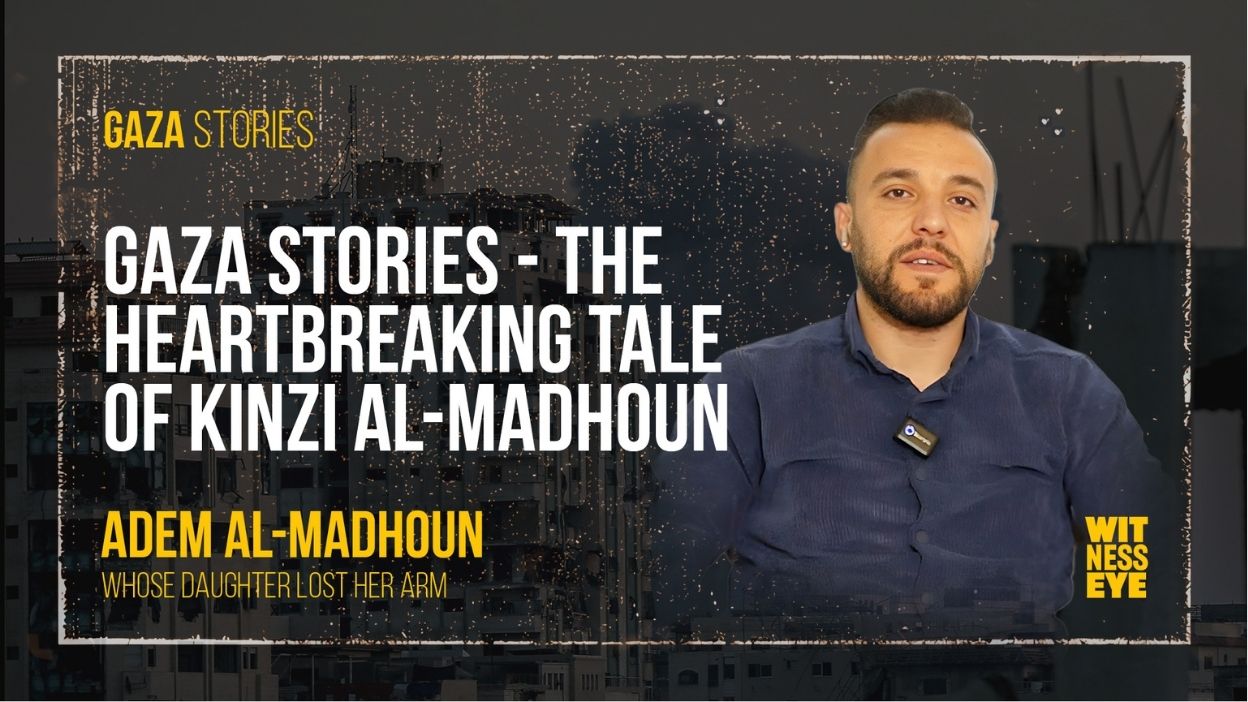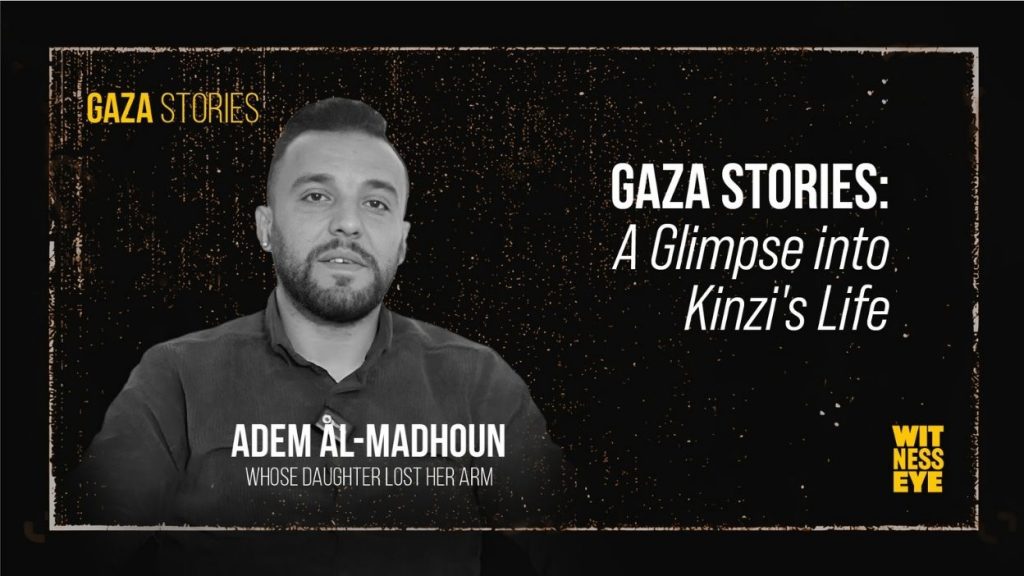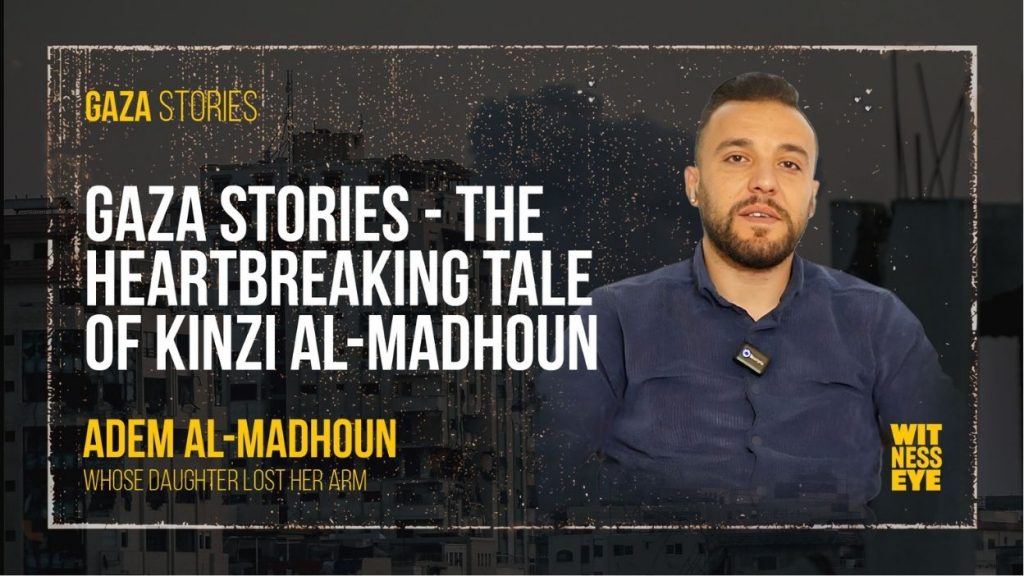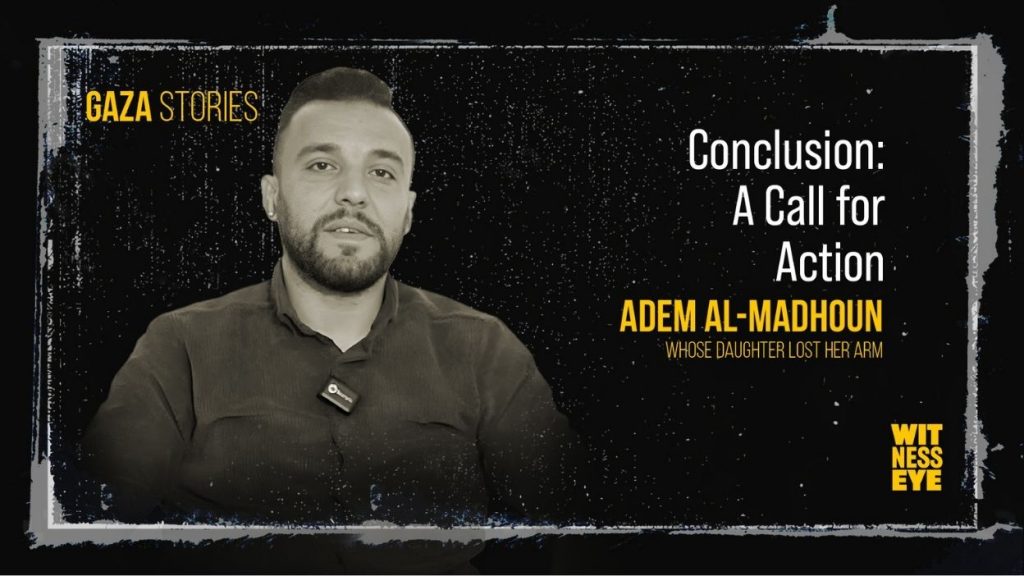
In the midst of the ongoing humanitarian crisis in Gaza, the stories of resilience, trauma, and loss are shared by countless families, each with their own heartbreaking experiences. One such story is that of Kinzi Al-Madhoun, a young child who was severely injured during the war in Gaza. Her story, alongside her father, Adam Al-Madhoun, highlights the unbearable toll of conflict, particularly on innocent children. The Heartbreaking Tale of Kinzi Al-Madhoun …

Gaza Stories: A Glimpse into Kinzi’s Life
Kinzi, a six-year-old girl, found herself caught in the chaos of war. She lost her right hand, suffered a severe head injury, and endured burns and fractures on her body as the result of a bombing in Gaza. Her journey from the ruins of Gaza to a hospital in Ankara for medical treatment is one of both survival and struggle.
In an exclusive interview with Witness Eye, Kinzi and her father Adam shared their experiences, offering a glimpse into the harsh reality of life for civilians in Gaza. They are now in Turkey, seeking treatment, but the scars of the war remain.
The Day of the Attack: A Family Shattered
The day of the bombing that altered the Al-Madhoun family’s life forever was October 21, a tragic day that Adam vividly recalls.
“We had been displaced several times,” Adam explains, “We moved from the northern Gaza Strip to the central area, trying to escape the violence. But despite all our efforts to find safety, we were bombed in the Deir al-Balah area.”
This was not just an attack on a house; it was an attack on a family. Kinzi, her mother, sister, and grandfather were all in the house when it was bombed. Tragically, Kinzi’s grandfather was killed in the attack, and Kinzi herself was left critically injured.
“I couldn’t believe what had happened. Kinzi’s injuries were severe, her right hand was amputated, and she had fractures in her pelvis and leg. It was a nightmare,” Adam recounts with a voice that wavers between grief and disbelief.
Gaza Stories: The Struggle for Survival
In the aftermath of the attack, Adam and his family were left to pick up the pieces of their shattered lives. The journey to find medical care for Kinzi was fraught with obstacles. Adam recounts how he received the news that his daughter was critically injured and might not survive.
“The call came while I was at the hospital in Al-Nuseirat. I couldn’t hear the details due to the bad network. When I finally understood what had happened, I rushed to find a car to take me to the hospital in Deir al-Balah. It was a desperate situation, and the roads were dangerous,” he says.
When Adam finally reached the hospital, he learned that Kinzi was in critical condition. Her head injury was severe, and the doctors were uncertain if she would survive. “Kinzi was barely alive when they managed to stabilize her. It took an hour before we knew she was going to make it.”
In the following days, Kinzi underwent multiple surgeries, first in Gaza and later in Turkey, where she received much-needed medical care. The physical toll of the war, however, was only part of her struggle. The emotional and psychological impact was equally devastating.
Gaza Stories: A Child’s Silent Suffering
The aftermath of the attack left Kinzi with permanent injuries. Her right hand was amputated, and she struggled with the psychological impact of her trauma. In the early days after the attack, Kinzi asked difficult questions about her injuries, trying to comprehend the enormity of her loss.
“Kinzi kept asking if all children who were bombed lost their hands,” Adam recalls. “She would look at other children and wonder if they had the same experience.
Her silence was often more painful than the questions.” Kinzi’s emotional pain was compounded by the practical challenges of daily life. Simple tasks, like dressing herself or playing with toys, became monumental challenges without the use of her right hand.
“She would try to clap with her left hand, or ask me to help her,” says Adam. “It was heartbreaking to watch her struggle with things that used to come so easily.”
Despite the physical and emotional pain, Kinzi has shown remarkable resilience. Adam shares that she is now receiving psychological support, which has helped her cope with the trauma. “Kinzi was always a child full of love, loved by everyone who knew her,” Adam says. “But now, she tells everyone she’s fine. She has come a long way in her recovery.”
<div style=”max-width: 560px; text-align: left;”><iframe src=”https://www.instagram.com/reel/DIuDWhOyfcc/embed” width=”320″ height=”600″ frameborder=”0″ scrolling=”no” allowfullscreen=”allowfullscreen”>
</iframe></div>
Gaza Stories: The Hope for Justice
While Kinzi’s recovery continues, the family’s quest for justice is far from over. In the face of overwhelming odds, Adam remains hopeful that one day there will be accountability for the suffering caused by the conflict.
“We have a deep belief in justice,” Adam explains,
“But in this reckless world that only understands the language of power, that looks at our cause with one eye and with complete bias toward the occupying state, we don’t expect fairness from it.
However, we hope for justice from God for Kinzi and the rest of the children in Gaza.”
The search for justice is a common thread in many Gaza Stories. Families who have lost loved ones or suffered injuries in the conflict often find themselves navigating a broken legal system, where accountability is rare.
Despite these challenges, Adam remains determined. “Kinzi’s loss is more than just a personal tragedy. It is a reflection of what the people of Gaza are enduring every day. We need the world to see the truth and hold those responsible accountable.”
Gaza Stories: A Family’s Call for Support
The family’s story is one of survival, but it is also a call for global solidarity. The humanitarian needs of families in Gaza are vast, and support is needed now more than ever. Families require comprehensive medical care, psychological support, and, most importantly, the opportunity to reunite with their loved ones.
“The hardest part is not just the physical injuries,” Adam says. “It’s the separation from family. Kinzi misses her mother and her siblings. As Adam explains, “We are fortunate that Kinzi was able to receive treatment abroad, but there are tens of thousands of children in Gaza who are still waiting for help.”

Gaza Stories: The Future of Kinzi
Looking ahead, the family remains hopeful for Kinzi’s future. While her injury has left an indelible mark on her life, there is a possibility that she will one day receive a prosthetic arm. Medical professionals have assured Adam that Kinzi can eventually get an artificial arm, although it will need to be adjusted as she grows.
“Kinzi is still young, and the technology exists to help her,” says Adam. “But there are so many children in Gaza who will never have the chance to get that kind of treatment.”
As Kinzi continues her journey of recovery, her story serves as a reminder of the resilience of Gaza’s children and the urgent need for international support.

Conclusion: A Call for Action for Gaza
Kinzi’s story is just one of many Gaza Stories, each highlighting the devastating impact of the conflict on the lives of children and families. While the world watches, the people of Gaza continue to endure unimaginable hardship, with little hope for justice or accountability.
As we witness the struggles of families, it is crucial that the international community steps up to provide the support that is so desperately needed. The children of Gaza deserve a future free from violence and pain. They deserve justice, healing, and the chance to live their lives in peace.
Now, hear the testimony of Adam Al-Madhoun and his daughter Kenzi—in their own words, a father and a child marked by the war’s wounds—carrying Gaza’s grief, memory, and unyielding call for justice into the record of history.
Published By Besa Witness Eye
Stay Connected with Witness Eye
Follow us on our official channels:
